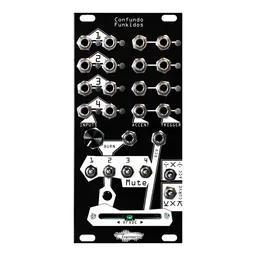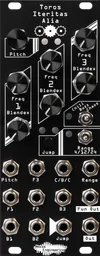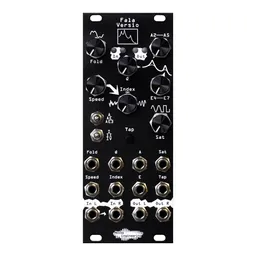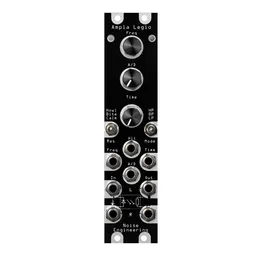Last week, we introduced the Legio platform, talked about platforms, and chatted a bit about the Virt Iter Legio firmware. This week, we’ll be talking about the second Legio firmware, Librae Legio.
Before we jump into the details: both Legio modules are available for purchase NOW. And if you want to learn more about the stereo oscillator firmware Virt Iter Legio, you can read last week’s blog here.
Librae Legio: the dreamy dynamics processor you’ve always wanted
Librae Legio was our second concept for the Legio platform. Here at NE, we’re all big fans of dynamics processing, and we wanted to bring some arguably underutilized techniques to the Eurorack world. The Legio platform seemed like the perfect place, so we started development.
Librae Legio isn’t a traditional compressor or an emulation of existing hardware. We decided to go a completely new direction with it, creating custom algorithms that provide a wide range of processing options with just a few parameters.
Librae can do compression (because who doesn’t love compression?), but it can also do expansion. If you’re not familiar, expansion is a slightly less common way of processing sounds that makes loud sounds louder and quiet sounds quieter, thus increasing the amount of dynamic range in a signal.
Librae also applies limiting to the end of its processing, so your mix won’t get too wild even with more extreme settings. Finally, Librae features a noise gate: lots of compression and limiting can make any noise in your system extra noticeable, so with the flick of a switch you can add in a subtle noise gate (or a more aggressive one if that suits you) that’ll keep things nice and quiet.
Does Librae Legio have saturation?
Yes! It’s no secret that we love distortion here at NE. Commonly used in end-of-chain processing, we decided that we’d round out Librae’s featureset with a nice bit of saturation…
…and then we decided that we needed more distortion. So the encoder at the top of the module selects between two different types of distortion: a gentle saturation to the right and a zero-crossing distortion to the left. Both of these distortion algorithms can be very subtle and are great for rounding out a mix, but you can also crank them to get things crunchy.
Oh, and, of course, there’s an FSU input. We love FSU inputs. Patch in a high gate and everything gets squished and distorted as much as possible.
How transparent is Librae Legio?
You know how when you get a new jar of peanut butter the top is all smooth and perfect? That’s how smooth Librae Legio’s compression sounds.
In development, we spent a huge amount of time dialing in the sound of Legio’s processing. We wanted it to be as smooth and transparent as possible while still offering some more extreme options. I’ve used it in my patches on everything from hard-hitting techno to sparse, delicate ambient patches, and I can always find a setting that glues things together without causing any unwanted compression artifacts.
Of course, sometimes you want things to sound squished, and don’t worry—Librae can do that, too. It just doesn’t have to do that.

Does Librae Legio do sidechain filtering?
Librae Legio is designed primarily for end-of-chain processing, and as such it doesn’t have a dedicated sidechain input. However, we did add in a sidechain-filtering parameter called Tilt: you can engage this to emphasize the low end or the high end of the signal being processed before it hits the sidechain of the dynamics processor, which changes how Librae sounds and responds to incoming audio.
Generally, the High setting makes things move more and makes the sound a bit punchier, and the Low setting glues things together more. It’s all very dependent on the types of sounds being processed, though, so it’s worth tweaking the Tilt switch and seeing what works best for your patch.
Enough chit chat: let’s get to some sounds.
Take a listen
Here’s the manual video showing off the sound of Librae Legio and walking through its controls. Spoiler alert: it’s pretty awesome.
The history of Librae Legio
Librae Legio is an idea that has existed for a long time. We’ve long used various compressors in almost all of our systems, but we always felt that we wanted something more flexible, more transparent, and with more types of dynamic processing than was currently on the market.
When we started developing the Legio platform, we had many, many ideas for various firmwares (currently there are 18 in various states between a notebook and actual development). While figuring out the various options we had and deciding what we wanted to launch the platform with, we just kept coming back to dynamics processing: we had a lot of ideas that didn’t need too many parameters, and a compact, stereo module seemed like the perfect platform.
Librae started out as a simple compressor/limiter: as a proof of concept, it had only two parameters, and worked more like a traditional compressor. We tried it out in a few patches and liked the way it sounded, but wanted more flexibility and character. The expansion side of the Room knob was added, and we increased the range of the Ceiling knob to allow for more extreme settings. We also added in the Color knob: initially, it only did saturation, but after some experimentation we decided another flavor of gentle distortion would be a welcome addition. Stephen proposed zero-crossing distortion, a sound often found in traditional analog mixing gear.
At this point, we had a solid module and it was already making its way into most of our patches. As a final touch, Brandon suggested we add the sidechain filter switch. This allowed Librae to be tweaked to better fit whatever sort of sounds were being run through it, and after some thorough testing (well, jamming out to awesome patches run through Librae) we decided it was ready for prime time.
Go get yours today!
Virt Iter Legio and Librae Legio are both shipping now, and many retailers have them in stock already. Since both Librae Legio and Virt Iter Legio are part of the same platform, you can get just one (for now) and try them both by changing the firmware. Plus, we’re actively working on new firmwares for our platforms, so there’s always new things to try.
So, what’re you waiting for? Head to your favorite retailer or our webshop and pick up a Legio or two today!







